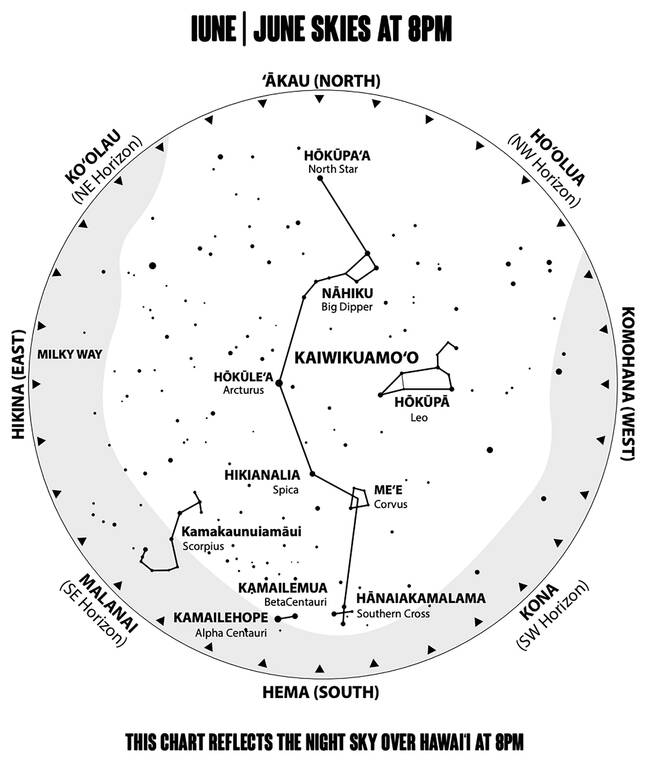
Mahalo for supporting Honolulu Star-Advertiser. Enjoy this free story!
Hokupa‘a, also known as Polaris or the North Star: We gaze at it and use it as a tool for navigation across the world, but what do we know about the star? Or should we say, stars?
What we see in the night sky as one star is really three: the yellow supergiant Polaris Aa, plus the fainter Polaris Ab and Polaris B. The famous astronomer William Herschel discovered the smaller star in the late 1700s. Since then Hokupa‘a continues to mystify astronomers and enthrall the public.
Now research from the Canada-France-Hawaii Telescope has revealed new details about Hokupa‘a, shedding new light on one of the most famous stars in the sky.
Hokupa‘a belongs to a category of stars known as classical cepheids. Cepheid stars pulse at a regular rate, varying in brightness over a specific period of time. They are so consistent that astronomers use measurements of cepheids to measure distances to nearby galaxies.
Hokupa‘a is an unusual cepheid. While its brightness, temperature and radius vary over a four-day period, the variability of Hokupa‘a also changes over a longer period of time.
The time between pulses increases by eight seconds per year. The star is brighter now than in the past, perhaps as much as 2.5 times brighter than it was during ancient Greek times, but varies less.
Enter James Barron, a graduate student at Queen’s University in Ontario, and his team. Barron undertook a project trying to detect magnetic fields in classic cepheid stars using the Canada-France-Hawaii Telescope.
CFHT is home to a highly specialized camera called ESPaDOnS, which takes the light from a single star and breaks it into the star’s rainbow, or spectra, enabling astronomers to study the star’s properties.
ESPaDOnS is also used to measure the magnetic fields of stars, a unique capability. We see evidence of the sun’s magnetic field in phenomena like sunspots and solar flares. Barron detected, for the first time, Hokupa‘a’s magnetic field.
“I was analyzing the data that had been obtained the night before, and I was excited to see that Polaris’ magnetic field had been observed. When I saw the results, I couldn’t believe my eyes! I actually checked with my thesis adviser that the results were real,” said Barron.
Hokupa‘a’s magnetic field is very different from any other known cepheid magnetic field. Barron and his team hope to uncrack this chicken-and-egg situation — is the magnetic field different because of the star’s unique variability, or is the unique variability the cause of the magnetic field?
Special events
>> Supermoon: On June 14 the full moon will take place while the moon is at perigee, the point of the moon’s orbit when it is at its closest position to Earth. When the moon is full or close to perigee, the moon appears slightly bigger and brighter in the sky.
This event is often called a supermoon. Supermoons can be up to 15% brighter than an average full moon.
Will you be able to tell the difference? Maybe! Like any astronomical event, the darker the location, the more likely you will be able to notice the increase in brightness. Regardless, full moons can be incredibly cool to observe, particularly here in Hawaii.
While the moon is the same size throughout the night, due to an optical illusion, it looks bigger at moonrise. As the moon rises, we observe it moving through more air at the horizon than directly overhead.
Also, when Kilauea is erupting, the moon passes through the vog as it rises, much like the sun passes through the vog layer when setting. This lends a golden hue to the moon as it rises over the ocean.
With the optical illusion at moonrise, the supermoon and the golden color due to vog, this month’s full moon should look pretty neat as it rises in the east.
>> Summer solstice: June 21 marks the Northern Hemisphere’s summer solstice, the day when Earth’s North Pole is at its maximum tilt toward the sun.
This 23.5-degree tilt is responsible for Earth’s seasons and the changes in the amount of day versus night we see throughout the year. On the summer solstice, the Northern Hemisphere experiences its longest period of daylight; the day length for Honolulu will be 13 hours and 25 minutes.
As one moves farther north, the sun sets later and later on the solstice. At the North Pole the sun will set at 12:23 a.m. and rise at 2:59 a.m. Factoring in twilight, the sky will never get dark at the North Pole on that day.
The summer solstice is an important event worldwide. Many cultures celebrate the solstice, building monuments and developing rituals based on the longest day of the year. Similarly, traditions evolved around the winter solstice, the longest night of the year.
Evening observations
The spring-summer star family of Kaiwikuamo‘o (the Backbone) will stretch across the evening sky throughout June.
To follow the full star family, start by locating Nahiku (the Seven), also known as the Big Dipper, in the northeast. Draw a mental line between the two stars, Hikukahi and Hikulua, at the beginning of the “cup shape” of the Big Dipper northward to a faint star, Hokupa‘a.
Return to the Big Dipper and follow a line south from the handle of the Big Dipper to the Red Giant and zenith star for Hawaii, Hokule‘a (Arcturus), the fourth- brightest star in the night sky. Continue south and cross the celestial equator to Hikianalia (Spica) and to the trapezoidal constellation Me‘e (Corvus). Extend a line through the center of Me‘e due south and you come to a cross-shaped constellation, Hanaiakamalama (the Southern Cross).
In the southern sky, observers will be able to see some notable stars and celestial objects.
Just next to Hanaiakamalama, we can see the two pointer stars Kamailehope (Alpha Centauri) and Kamailemua (Beta Centauri).
With our human eyes, these two stars appear to be about the same brightness, but they are quite different from each other. Beta Centauri is a triple-star system of bright stars about 400 light-years away from us, meaning that it takes 400 years for light to travel from the star system to Earth.
Alpha Centauri, also a triple-star system of smaller and fainter stars, is the closest star system to our sun at only 4 light-years away.
Not far from these notable stars, careful observers will also be able to see the fuzzy light of a unique astronomical object, Omega Centauri.
To find Omega Centauri, locate Hanaiakamalama. From the crux of the cross, draw a 45-degree line up to the northeast; as you follow this line, you will see a fuzzy smudge about 12 degrees north of Kamailemua — this is Omega Centauri. Omega Centauri is a globular cluster containing about 10 million stars as it orbits around the plane of the Milky Way galaxy.
Morning observations
Early-bird stargazers will enjoy a very different perspective of the night sky.
As summer approaches, the sun will rise earlier and nights will get shorter: Throughout June the sun will rise just before 6 a.m., and dawn will color the sky starting just before 5:30.
Throughout the past few months, Venus, Jupiter, Mars and Saturn have all been visible in the early morning sky, and observers have been watching as the planets dance along the eastern horizon. Early this morning Jupiter and Mars were less than 1 degree away from each other, concluding the series of planetary conjunctions that have been decorating the morning sky.
While this is the last of the planetary conjunctions for the near future, the planets will remain in the early-morning sky with Venus and Jupiter, the brightest planets standing out amid the dawn.
Starting the second week of June, all five planets that are visible to our naked eye will be in the sky at the same time. Mercury, which is consistently the most difficult planet to spot, will peak above the northeastern horizon just before dawn. The incredibly bright planet Venus will be just above faint Mercury, while Mars, Jupiter and Saturn will create a gently arcing line toward the southwestern sky.
Star Chart June 2022 by Honolulu Star-Advertiser
The ‘Imiloa Astronomy Center of Hawai‘i is a center for informal science education at the University of Hawaii at Hilo showcasing astronomy and Hawaiian culture as parallel journeys of human exploration.
Source: Star Ads





